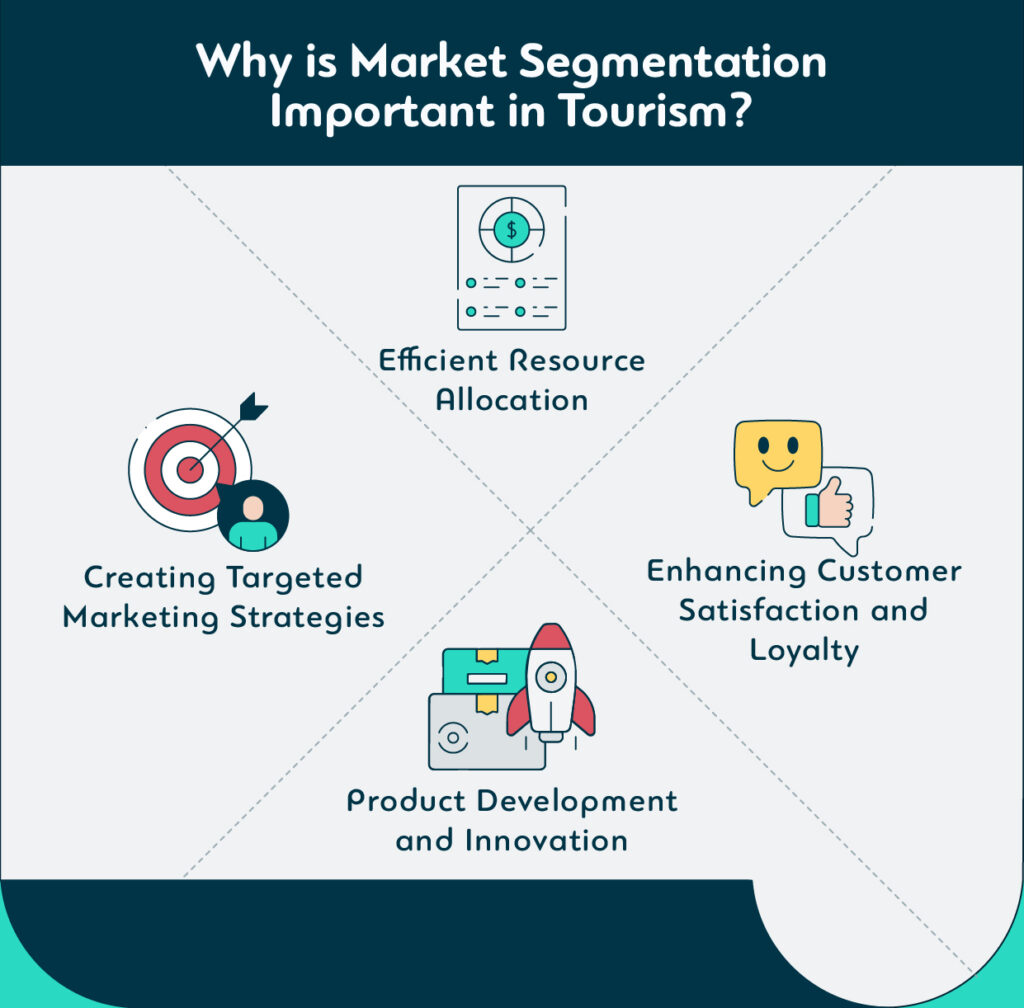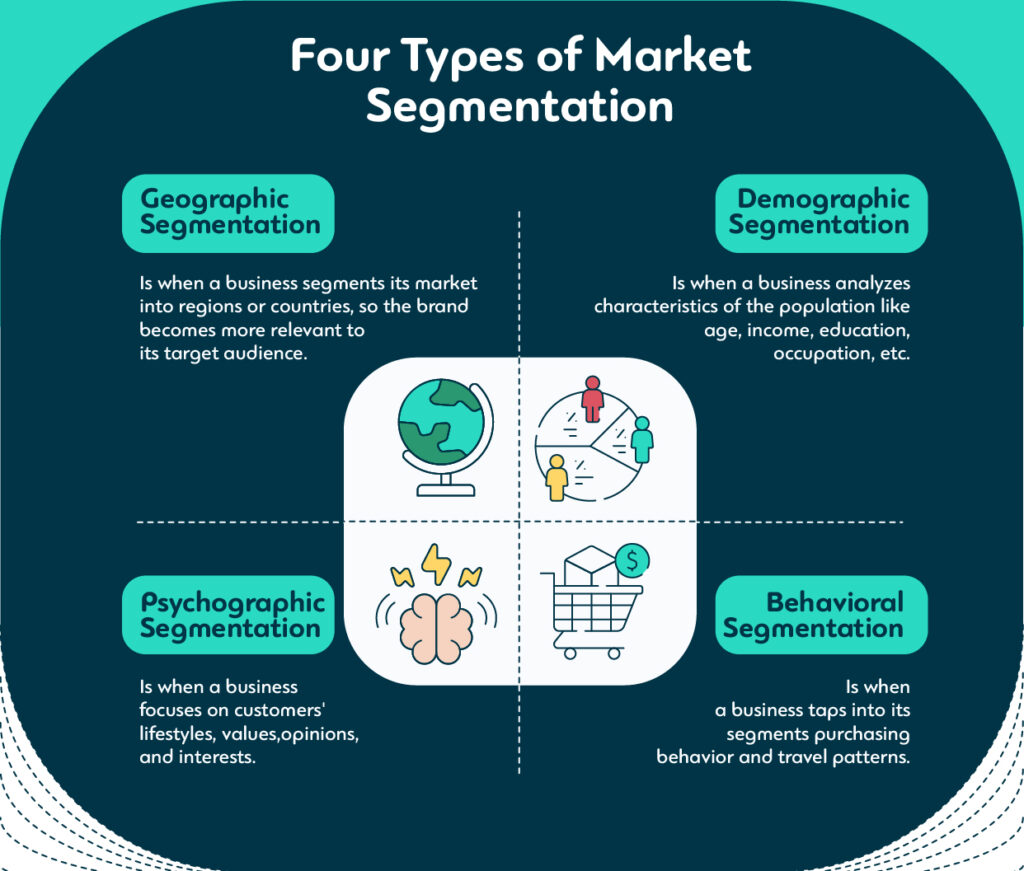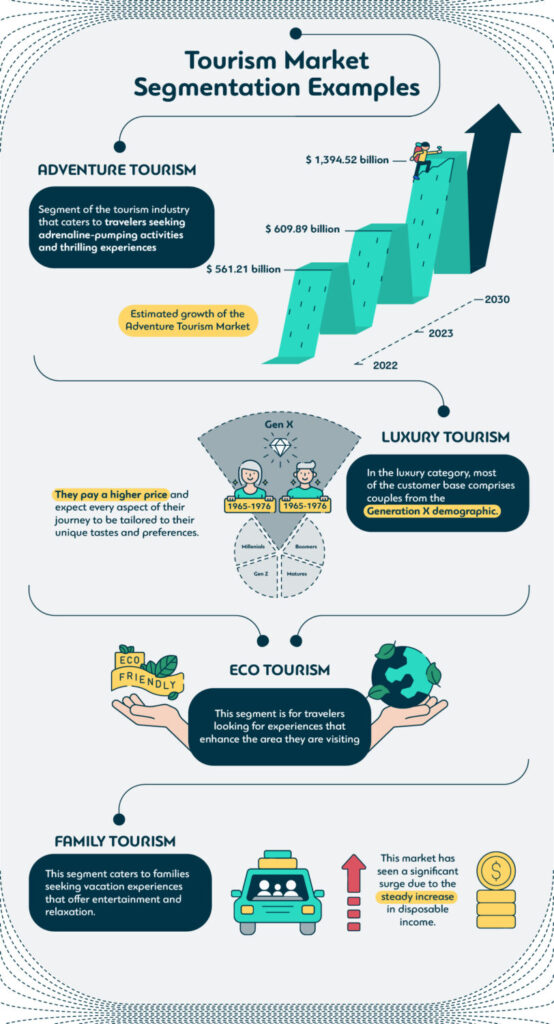The Vital Role of Market Segmentation in the Tourism Industry

The tourism industry is an ever-growing and competitive landscape, presenting both challenges and opportunities for businesses operating within it. This is where market segmentation comes in handy.
In this blog post, we will discuss what market segmentation is, the importance of market segmentation in the tourism industry, and how online travel agencies can benefit from it.
What is Market Segmentation in the Tourism Industry?
Market segmentation in the tourism industry is the process of grouping a large market into subgroups of customers with similar needs and preferences.
Definition: Dividing a market who have different needs into groups that have similar needs.
The main goal of segmentation is to classify consumers based on shared interests. This results in content that gets seen, messaging that gets heard, and products and services that get sold.
The Role of Market Segmentation for Online Travel Agencies (OTAs)
Segmentation allows online travel agencies to cater to different types of travelers with unique and diverse interests, lifestyles, preferences, aspirations, expectations, and habits.
The challenge OTAs and those within the tourism sector face is that they are all selling the exact same product. For example, if a traveler wants to say at the Four Seasons Resort in Dubai, they can book directly or via Booking.com, Hotels.com, and Expedia.
Companies that cannot differentiate themselves in the market become interchangeable with similar ones. Consequently, customers base their purchasing decisions solely on the cost of the product or service, leading to decreased profit margins.
When you segment-specific markets, you stop competing over price and start competing over value.
The Benefits of Effective Market Segmentation
There are several benefits of effective market segmentation for both the end user and online travel agencies.
The Benefits of Effective Market Segmentation for End Users
- Products and services are consumer-centric
- Segments feel seen and heard
- Consumer needs exceed expectations
- Improve travel experience
The Benefits of Effective Market Segmentation for OTAs
- Targeting the right consumers
- Offer personalized travel products and services
- Identify new and unmet needs
- Identify unexplored segments
- Differentiate from the competition
Why is Market Segmentation Important in Tourism?
1. Creating Targeted Marketing Strategies
Market segmentation enables OTAs to develop more effective marketing strategies that attract and retain customers. This is because segmentation allows them to target different customer clusters with tailored offers and messages that burn through the noise as opposed to cookie-cutter campaigns.
Backpackers and business travelers have different interests, just as families and couples on holiday have different interests. Once you have identified your segment, you can target them based on what interest them.
One simple strategy when it comes to email marketing is to segment your email list based on buyer personas. This way, you can customize your messaging to address their specific interests and needs instead of sending the same email to everyone.
2. Efficient Resource Allocation
The more effective marketing strategies become, the more efficient businesses become at allocating their resources. This is because they stop wasting resources on irrelevant products and services that do not appeal to their customer base because they know exactly who their customers are, what they want, and how to target them.
A brand that knows who their customer is can create products and services that their customers want and tailor their messaging to attract the people most likely to purchase them.
This means businesses can allocate their resources more efficiently by focusing on what their customers actually want and need instead of what they ‘think’ they want and need.
3. Product Development and Innovation
Market segmentation helps businesses identify their customer’s needs and preferences, enabling them to develop and alter their products and services to meet their expectations. OTAs can create segment-specific offers and packages based on these insights.
Once you have chosen your specific segment or segments, it’s important to tailor your product to the unique characteristics of that segment. For example, offering a breakfast package for family travelers or a couple’s package for honeymooners.
Unique pricing options or personalized value add-ons can be developed for each segment. Price discrimination is a selling strategy OTAs can use to charge different rates to different customers for the same product or service.
For example, for hotel rooms, an OTA can:
- Sell at a higher rate based on what customers are willing to pay
- Sell at a lower rate based on what customers are willing to pay
The luxury travel segment has a higher tolerance for spending more money on their travel experiences and services. While the family travel segment is more likely to focus on finding the best deals or trying to get the most out of their money.
This can be key in identifying what price will make them jump at the opportunity and what price will make them run for the hills.
4. Enhancing Customer Satisfaction and Loyalty
The main goal of segmentation is to better serve the customer. As a result, businesses are better equipt to meet customer needs and expectations. Consequently, leading to an increase in customer satisfaction and loyalty.
By creating target marketing campaigns that resonate with prospects and customers, allocating resources efficiently, and developing products and services that meet the needs of each segment, businesses can deliver a higher level of customer satisfaction that results in repeat business and positive word-of-mouth.
For example, when you link the expectations and needs of your customers to the tour packages you create and sell, you’re customers are more likely to experience greater satisfaction.
To evaluate the potential of a segment, you can review 5C’s:
It’s important to identify whether the segment you would like to choose is a viable option. As while some segments may seem like a fit, they might not provide the type of scalability you desire for your business, or they might be too costly to acquire. Let’s take a look at several factors to take into account.
- Customer: Is the chosen segment ‘attractive’ in terms of profitability? (aka how much are they willing to pay)
- Condition: How big is the market size and growth rate? (market potential)
- Cost: How much does it cost to reach the chosen segment? (customer acquisition cost)
- Company: Is this segment compatible with the company’s objectives, capabilities, and resources? (company/segment fit)
- Competitors: Who are the main competitors? (Global OTA market share)
Now that we understand why market segmentation is so important, let’s take a look at the main segments of market segmentation.
What are the 4 Segments of the Tourism Industry?
The tourism industry has four main segments, which involve identifying and targeting specific customers and categorizing them according to their geographic, demographic, psychographic, and behavioral characteristics.
1. Geographic Segmentation
Geographic segmentation is when a business segments its market into regions or countries. This can help them understand where their target audience comes from so they can tailor their marketing campaigns and messages accordingly.
Segmentation by geographic location makes a brand more relevant to its target audience, and its resources get allocated more efficiently.
For example, according to Google Travel Insights, France has The United Kingdom, The United States, and Italy as their top 3 sources of inbound demand. OTAs and local businesses in France can use this knowledge to help them better understand the people visiting their destination and buying their products and services.
2. Demographic Segmentation
Demographic segmentation is when a business analyzes the characteristics of the population. For example, age, income, education, occupation, and several other factors.
These factors can help you fine-tune your marketing strategies to relate to that chosen segment. Just like consumer behavior changes, it does the same as we age. Similarly, those with similar income levels will also seek out similar travel experiences.
For example, those traveling as young adults will expect a different experience than seniors. One group is more likely to want to say at a hostel and backpack, while the other group would prefer to have their own room with a little bit more luxury.
This type of data can be used to determine the market size and potential of the demographic segment chosen. One key demographic that travel companies should focus on targeting is Gen Z. This generation consists of late teenagers to early adults who are known to be the largest and most ethically diverse generation in the U.S. and have grown up online.
3. Psychographic Segmentation
Psychographic segmentation is when a business focuses on customers’ lifestyles, values, opinions, and interests. This helps companies to identify different customer personalities and create more targeted marketing messages that resonate.
Psychographic segmentation allows brands to tap into the emotional triggers and pain points that make people buy. This type of data can be invaluable in understanding the customer journey your segmented audiences takes from beginning to end.
This data informs how a company decides to market itself and communicate with its audience. For example, if an OTA wants to market to Gen Z, it will differ from how they market to millennials or boomers.
4. Behavioral Segmentation
Behavioural Segmentation is when a business taps into its segments purchasing behavior and travel patterns. Brands can group behavior based on seasonality, frequency of purchases or trips, and the amount spent on travel-related products and services.
For example, many European countries can expect increased demand for travel to the region in the summer months. OTAs can use this knowledge to forecast demand surges, manage inventory supply and price their products accordingly.
Additionally, this can guide the types of promotional activities marketed. For example, in the summer months, travel agencies can create summer travel deals for their target audience to take advantage of.
The four segments are often used in tandem when planning out marketing campaigns. For example, an OTA creating an Ads campaign will likely target a specific segment that lives in a particular area with unique interests, values, and behaviors.
The data they collect above can help them target those more likely to buy instead of a broader audience that may not be interested in their offer. This allows the OTA to save money, reach more people with the right message, and increase their ROI.
Tourism Market Segmentation Examples
Tourism markets can be segmented into groups more likely to buy a certain type of holiday or experience. Many types of travel agencies are available, categorized based on several factors. Depending on the type of travel agency operated and the segment chosen.
These agencies may offer or specialize in certain kinds of trips, such as adventure tourism, luxury tourism, eco-tourism, and family tourism. We’ll take a deeper dive into each type below.
Case Study 1: Adventure Tourism
Adventure tourism is a growing segment of the tourism industry. This segment caters to travelers seeking adrenaline-pumping activities and thrilling experiences, such as skydiving, scuba diving, and mountain climbing.
Adventure tourism is usually associated with outdoor activities and adventure sports but also includes cultural activities such as trekking through remote villages. This often leads travelers to accommodations in tents or budget-friendly places.
The estimated size of the Adventure Tourism Market globally was around $USD 561.21 billion in 2022 and $USD 609.89 billion in 2023. If current trends continue, experts predict it will reach a whopping $1,394.52 billion by 2030.
Through market segmentation, businesses can identify adventure-seeking customers they currently serve or want to serve and create travel products and packages around their interests.
Traveling allows people to leave their comfort zones and experience the thrill of the unknown. From discovering ancient ruins in the depths of the Amazon rainforest to swimming with sharks in South Africa, adventure tourism offers unforgettable experiences.
Case Study 2: Luxury Tourism
Luxury tourism is a high-end segment that caters to travelers seeking luxurious accommodations, services, and experiences.
Accommodation options in this segment are often high-end hotels, resorts, or private villas. They are known for their lavish amenities, stunning decor, and exceptional services.
In the luxury category, most of the customer base comprises couples from the Generation X demographic. The customers in this category have elevated standards compared to others. Given that they pay a higher price, they expect every aspect of their journey to be tailored to their unique tastes and preferences.
Case Study 3: Ecotourism
Ecotourism is a niche segment that caters to environmentally-conscious travelers seeking sustainable travel experiences.
Tourism of this kind is centered around awareness and preservation. Ecotourism involves responsible travel that carefully conserves, manages, and protects the environment and the local population’s well-being.
Travelers are looking for experiences that enhance the area they are visiting by participating in activities involving planting trees or supporting the local community.
Online travel agencies have been leveraging ecotourism in their marketing strategies to attract travelers looking for sustainable experiences. For example, hotels and resorts use eco-friendly materials, energy conservation methods, and green products to be more sustainable.
Case Study 4: Family Tourism
Family tourism is a segment that caters to families seeking vacation experiences that offer entertainment and relaxation.
Family-friendly destinations offer various activities and attractions for different age groups and interests.
Many hotels offer spacious family suites or interconnected rooms that can easily accommodate larger groups. These accommodations often provide amenities like swimming pools, kids’ clubs, babysitting services, and entertainment.
The family tourism market has seen a significant surge due to the steady increase in disposable income. Nowadays, tourism is no longer considered a luxury but a must-have for families.
Conclusion
The travel industry is one of the most competitive industries in the world. Segmentation is a powerful tool that helps online travel agencies understand their target market’s unique needs and preferences, allowing them to better serve their segment-specific markets.
This is particularly crucial for online travel agencies, which must differentiate themselves from their competitors by offering personalized services that cater to their target audience’s unique interests and expectations.
Frequently Asked Questions (FAQ)
Online travel agencies can effectively use market segmentation data to identify customer needs, create targeted marketing campaigns, focus product development priorities, and inform pricing decisions.
Market segmentation data can be implemented to create more target marketing strategies as OTAs now know who they are talking to. They can efficiently allocate their resources to the tasks and activities they now will gain a greater ROI.
Additionally, they can use this data to improve their current and future product offerings.
Some common challenges in implementing market segmentation in the tourism industry include a lack of data and resources. Obtaining customer insights and data can be a lengthy process.
However, there are tools and resources that OTAs can use to gather the insights they need to make informed decisions, such as Google travel insights and customer interviews.
Another challenge is a lack of understanding of customer segments and needs. This is because consumer needs and preferences are constantly changing. OTAs need to stay on top of trends and changes to ensure their segment’s needs are still being met.
Online travel agencies can adapt their market segmentation strategies in response to changing customer preferences and market trends by regularly monitoring changes in customer needs, updating the data used for analysis, and testing new tactics.
OTAs can review their market segmentation strategies every six months to a year to ensure they are still consistent with current trends and expectations.
Yes, market segmentation can help online travel agencies manage crises. Many OTAs had no choice but to implement new strategies during the pandemic.
For example, as travel restrictions loosened and people could start traveling again, there was a lot of concern about getting stuck in a foreign country or being unable to get a refund if anything went wrong.
Specifically, behavioral segmentation helps understand consumers’ pain points and how you can cater to them. In the case of the pandemic, many businesses implemented flexible booking policies, such as free cancellation or no change fees.
Online travel agencies should consider targeting emerging market segments in the tourism industry. Travelers are increasingly seeking out unique and immersive experiences when they travel post-pandemic.
There has been a rise in the popularity of niche tourism, such as eco-tourism, wellness tourism, culinary tourism, and voluntourism. Additionally, millennials, Gen Z, solo travelers, family vacationers, digital nomads, and adventure seekers have recently gained more popularity.
These segments represent higher engagement and loyalty with travel brands, offering unique opportunities for differentiated experiences and services.
Subscribe to
our newsletter
Yay! You are now
subscribed to our
newsletter
Mize is the leading hotel booking optimization solution in the world. With over 170 partners using our fintech products, Mize creates new extra profit for the hotel booking industry using its fully automated proprietary technology and has generated hundreds of millions of dollars in revenue across its suite of products for its partners. Mize was founded in 2016 with its headquarters in Tel Aviv and offices worldwide.
Related Posts
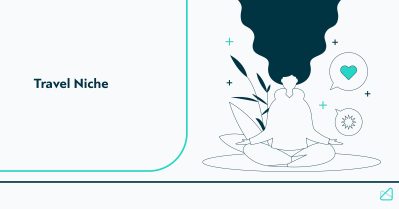
Travel Niche: What It Is, How to Leverage It, Case Studies & More
14 min. Niche travel is one of the few travel sectors that have maintained their pre-COVID market growth. By catering to specific traveler segments, niche travel developed products around adventure travel, eco-tourism, LGBTQ+ travel, and wellness retreats. Take adventure tourism as only one segment of the niche tourism market. In 2021, it reached 288 billion […]
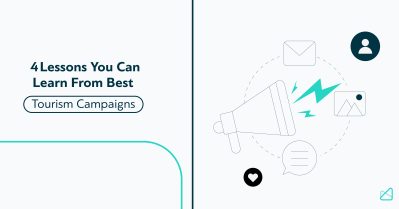
4 Lessons You Can Learn From the Best Tourism Campaigns
13 min. Businesses in the tourism industry rely heavily on marketing to generate leads and boost conversion rates. Tourism marketing is as old as tourism itself – and it always reflects the destination and service benefits relevant to the current travelers’ needs, wants, and expectations. In other words, tourism campaigns must constantly move forward, and […]
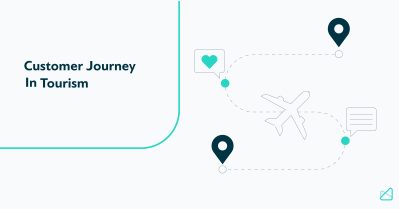
This is the Way to Create Memorable Customer Journeys in Travel and Tourism
21 min. The travel and tourism industry is an increasingly competitive space, with customers expecting more personalized and memorable experiences from their trips. With the rise of technology and social media, travelers have greater access to information and a wider range of options than ever before. Journey mapping offers travel agencies a way to gain […]

